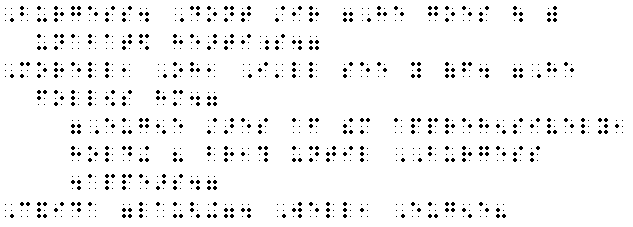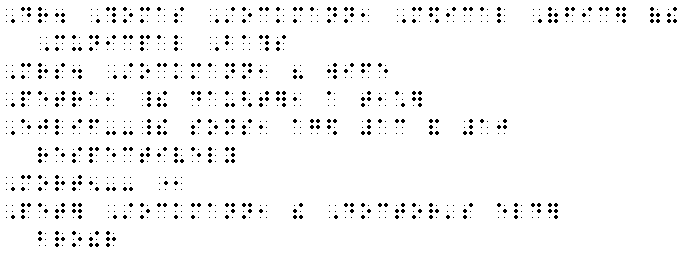|
Complete documentation on plays, dialogue, and interview format can be found in Rule 9 of the Braille Formats code.
In transcribing plays, dialogue, and interviews, the transcriber fundamentally follows the print copy for formatting. Some specifics that are of importance:
- use only a single capital indicator (dot 6) for names of characters, even if the print copy shows all capitals or some type of special typeface for the name of the character
- in plays, oftentimes the cast of characters will be printed as a column, with the name of the character in the left-hand column and his/her identifier in the right. This should be brailled as a list. If there is no punctuation between the name and the identifier, insert a dash (36,36)
- follow the print for things like block or indented paragraphs
- in transcribing stage directions, there is a difference between prose and verse dialogues. Prose is defined as "ordinary" language, non-rhyming and/or with no regular meter. Verse is defined as that writing that can be divided into metrical units. With prose dialogue, stage directions are started in Cell 5. With verse dialogue, use Cell 7. If the stage directions are embedded within the dialogue, follow the print.
A simple example:
OEDIPUS. Could I have told that you'd talk nonsense, that
You'd come here to make a fool of yourself, and of me?
TEIRESIAS. A fool? Your parents thought me sane enough.

In this example, we used single capitals for the character names. The print version has a period after the name, so we followed that format. Characters begin in Cell 1, with runovers in Cell 3. We followed the print format in terms of preserving the line structure (i.e., putting "You'd come here ..." on a new braille line.)
Another example, showing stage directions:
BURGESS. Dont stir (He goes out with unabated heartiness.)
MORELL, Oh, I'll see you off. (He follows him.)
(EUGENE stares after them apprehensively, holding his breath until BURGESS disappears.)
CANDIDA (laughing). Well, Eugene?

In this prose example, we have followed the print format for the stage directions that are within the lines of dialogue, based on Rule 9, §1d(2). Based on Rule 9, §1d(3), we have indented to Cell 5 for the standalone stage directions. Notice that there are no blank lines before or after the standalong stage directions. Notice that the rules state that if there is not parentheses or enclosure marks around the standalone stage directions, the transcriber should put them in. Also, notice that the text leaves out an apostrophe in the word "dont", and we have not included one either!
One more short example: in preparing a cast of characters, some variation from the print occurs:


In this example, we have dealt with the large curly bracket around the names of the boys by putting a dash (36,36) after the first name, then the identifier. For the second boy, we again used the dash, a space, then the ditto sign (5,2), based on Rule 9, §1a(3). Notice that we have ignored the italics used for the identifier.
|